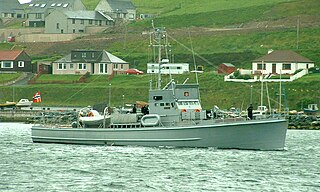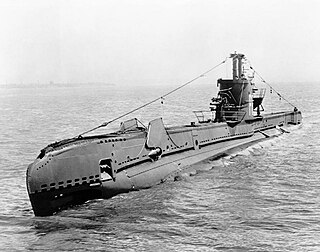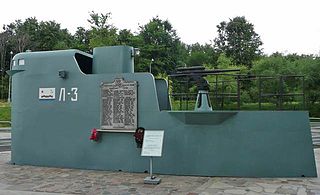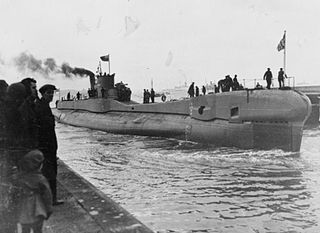
Vetehinen was a 500-tonne Vetehinen-class submarine that was constructed in the early 1930s, which served in the Finnish Navy during the Second World War. The submarine was the first ship of its class of three submarines. The name vetehinen means "merman".

HNoMS Hitra is a Royal Norwegian Navy submarine chaser that saw action during World War II. She is named after the Norwegian island of Hitra.

HMS Stonehenge was an S-class submarine of the third batch built for the Royal Navy during World War II. Completed in 1943, she made her initial patrol off Norway and was then transferred to the Far East, where she conducted two war patrols, during which she sank two Japanese ships. On her second patrol, Stonehenge disappeared with all hands and was declared overdue on 20 March 1944. The most probable cause of her sinking is that she hit a mine, but her wreck has never been found.

HMS Sickle was a third-batch S-class submarine built for the Royal Navy during World War II. Completed in 1942, she made her initial war patrol off the Norwegian coast. Sickle then sailed to Gibraltar, from where she conducted one patrol, then to Algiers, French North Africa. From 10 May to 10 October, the boat patrolled the Gulf of Genoa five times and sank a German submarine as well as three minesweepers and an escort ship. She then moved to Beirut, French Lebanon, and conducted two patrols in the Aegean Sea, sinking three caïques and a merchant ship, in addition to landing resistance operatives in Greece.

HMS Stratagem was a third-batch S-class submarine built for the Royal Navy during World War II. Completed in 1943, she made her first war patrol off Norway before she was sent to the Far East, where she conducted three war patrols. On her second, she shelled installations on a Japanese-held island. Her only success came on her last patrol, when she torpedoed and sank a Japanese oil tanker. Soon after, she was spotted by aircraft and depth charged by a destroyer. She was forced to surface, and was scuttled to prevent her capture. Ten crew members escaped the sinking submarine and were taken prisoner, of whom only three survived the war.

HMS Syrtis was a third-batch S-class submarine built for the Royal Navy during the Second World War. Completed in 1943, Syrtis spent most of her career in the Arctic, off Norway, other than a single patrol in the Bay of Biscay,

HMS Simoom was a third-batch S-class submarine built for the Royal Navy during World War II. She was laid down on 14 July 1941 and launched on 12 October 1942.
HMS La Malouine was a Flower-class corvette of the Royal Navy, serving during the Second World War. Originally ordered by the French Navy under the same name, following the fall of France, the ship was seized by the United Kingdom and commissioned into the Royal Navy in 1940. The corvette remained in service until being broken up in 1947.

Riilahti was a Ruotsinsalmi class minelayer of the Finnish Navy. Riilahti was commissioned in 1940 and sunk in 1943. The vessel was named after the battle of Riilahti, which was fought between Sweden and Russia in 1714.
Fyodor Alekseyevich Vidyayev was a Soviet Navy submarine commander during World War II. He was killed in action in 1943.
Щ-213 was a Soviet Navy Shchuka-class submarine, Type X. She was built at the Sudostroytelnyi zavod imeny 61 kommunara in Mykolaiv, Ukrainian SSR, and entered service in October 1938 with the Soviet Black Sea fleet.

Submarine warfare in the Black Sea in World War II during 1941 primarily involved engagements between submarines of the Soviet Black Sea Fleet attacking Axis merchantmen defended by Romanian and Bulgarian warships. These engagements were a part of the naval Black Sea campaigns between Axis and Soviet naval forces.
The action of 6 December 1941 was a confrontation between the Bulgarian and Soviet navies in the Black Sea during World War II, taking place near the Bulgarian coast at Cape Emine.

The Soviet Navy launched the Soviet submarine Baltic Sea campaign in 1942 to harass the strategic iron-ore traffic from neutral Sweden to Nazi Germany during World War II. The Soviet Union and the German Reich fought each other on the Eastern Front (1941-1945) during the war. The Allies also launched other operations - especially involving the Royal Navy - against the traffic.

The Soviet submarine Baltic Sea campaign in 1943 was launched by the Soviet Navy to harass the strategic iron ore traffic from neutral Sweden to Nazi Germany on the Eastern Front during the WWII. Other operations were launched by Allies, especially by the Royal Navy. The offensive was a repetition of the previous campaign in 1942 but resulted in a failed outcome.
Submarine warfare in the Black Sea in World War II during 1942 involved engagements between primarily submarines of the Soviet Black Sea Fleet attacking Axis merchantmen defended by Romanian and German naval warships. These engagements were a part of the Black Sea campaigns between Axis and Soviet naval forces.

Submarine warfare in the Black Sea in World War II during 1944 involved engagements between submarines of the Soviet Black Sea Fleet attacking Axis merchantmen, defended by Romanian and German naval warships, as well as German U-boats and Romanian submarines attacking Soviet merchants on the eastern Black Sea. Before the conclusion of the campaign, Romania joined the Allies after King Michael's Coup. These engagements were a part of the naval Black Sea campaigns.

The Soviet submarine Baltic Sea campaign in 1944 was launched by the Soviet Navy to harass enemy shipping and naval military assets of the Nazi Germany on the Eastern Front during World War II.

The Barents Sea campaign in 1941 was a submarine operation in the Arctic waters of the Barents Sea during World War II. It was a combined Soviet and British campaign, with boats departing from Polyarny to harass German shipping along the Norwegian coast.
Shch-421 was a Shchuka-class submarine of the Soviet Navy. She served in the Northern Fleet during World War II. She was led by commander Nikolai Lunin, before he was replaced by his second-in-command Fyodor Vidyayev.














